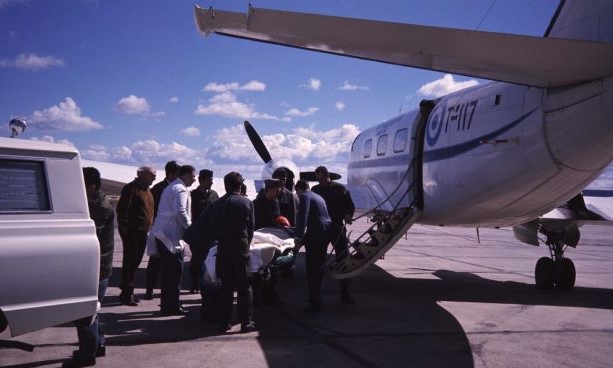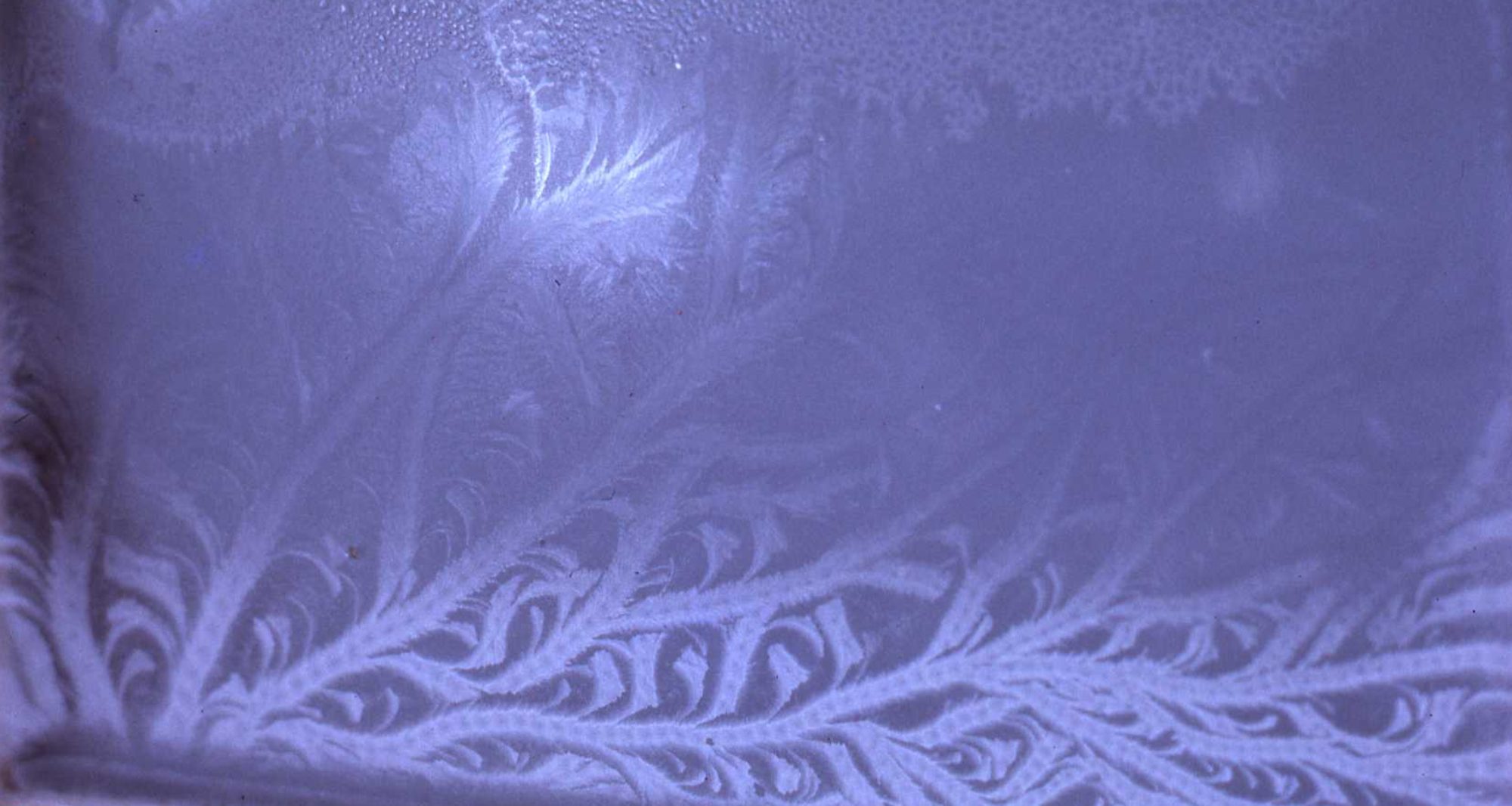Header Photo: Steve Vallance
Rock Hudson’s Evacuation – Adelaide Island Perspective – Steve Vallance
On the morning Sunday October 1st 1972 Graham (Genghis) Wright contacted Base T concerning John (Rock) Hudson. For 2 days he had been suffering increasing symptoms and signs of a small bowel obstruction. He had severe abdominal pain not helped by 100mg of oral pethidine. Genghis felt, correctly, that an omnopon injection was needed but wanted medical approval. Rock had suffered intermittent stomach pains since his appendicectomy before leaving the UK.
Continuing……
Scar tissue from this (adhesions) tethering the bowel was the most likely cause. Genghis was advised that he should give Rock omnopon as required, but also that he should ask Dave Singleton and Neil McNaughton, who were a day’s sledging away for help. The situation was very serious.
By the textbook, without surgery, Rock would likely not survive more than 3 days. The one positive thing was that Rock had had only one small vomit and after the first 24 hours was able to drink some tea. There was no option for intravenous fluids so the only hope was that Rock could drink enough to keep his kidney’s working. After a radio schedule with the Senior Medical Officer in Port Stanley, Rock was commenced on antibiotics with oral tetracycline. Another schedule with Mick Pawley (BC Stonington) followed and a request was made to head office for an evacuation.
When the evacuation was requested BAS planes were still over wintering in Toronto, Canada and were not expected at Adelaide Island until the end of October. Fortunately Bert Conchie and Dave Rowley, the pilots and the air mechanics, Dave (Jockali) Brown and Rob Campbell-Lent were already in Toronto to oversee the preparation of BAS’s second new Twin Otter “Alpha Quebec”. However, “Alpha Papa” was ready to fly. Bert and Jockali were able to leave Toronto on Tuesday October 3rd and flew to Punta Arenas in 6 days, approximately 10 hours flying per day. At the same time help was requested and offered from Argentina (I presume at government level). They had no planes on the Peninsula or ready to fly, but mobilised to have one plane at Base Marambio, 400 miles north of Base T, the day before Alpha Papa arrived in Punta Arenas. This was able to fly to Palmer Station on Anvers Island the next day. There was frequent radio contact between Adelaide Is. and Marambio over this whole period to keep them informed of Rock’s progress. The weather then closed in on the Peninsula for the next 4 days. On October 12th the weather cleared at Palmer Station, but not Adelaide Is. Bert and Jockali were able to fly to Anvers and meet up with the Argentinians. On Friday the 13th the weather cleared at Adelaide Is, but there was a tail wind at the landing strip at Anvers Is. The plan was for both planes to fly to Adelaide Is. but the Argentinian plane was a Series 2000 Twin Otter against the more powerful BAS Series 3000 Twin Otter. Bert risked take off and just managed to clear the base and advised the Argentinian pilot against attempting take off so, sadly, they returned to Marambio the next day, while Bert flew on to Adelaide Is.
Meanwhile, at what became known as Camp Omnopon, Dave and Neil were able to sledge over to Genghis within 24 hours. They were then able to organise a shift system to care for Rock. Unfortunately they found their medical supplies did not include the routine amount of Omnopon. By then it was evident that any evacuation for Rock was at least a week away and his pain needs could be compromised. The only possible option to get further assistance was from Fossil Bluff, 100 miles to the south west, but they only had Ski-Doos for transport. They had never previously been used for such a journey. Nevertheless, permission was agreed with Head Office. As luck would have it, sledge Lima (Mick Pawley, John Yates and Dennis McConnell) were about to arrive at Fossil Bluff having sledged over 50 miles in 2 days since hearing about Rock’s condition.
I insert here (in italics) an extract from Mick Pawley’s ‘drug run’ journey report noting that Andy Wager, who had a broken ankle, but mobile in a plaster, remained at Fossil Bluff – necessary for weather information when the planes eventually arrived. John Yates, surveyor also stayed behind to repair equipment and was later (5th Oct) assisted by the second survey sledge, Charlie (Paul Finigan and Paul Gurling)
“At this time the Stonington survey sledges were having trouble with their equipment and were heading for the Bluff to carry out repairs. On the 4th Oct. survey sledge Lima arrived Fossil Bluff. A few hours before Lima’s arrival, sledge Xray (Martin Pearson and Jim Whitworth) left the Bluff with a Muskeg and two Ski-Doos, planning to lay a fuel dump at Castle Rock depot. They travelled across the Sound okay but were forced to turn back when only a few miles up the Otter Glacier due to holes. They returned and camped at the foot of the Otter.
Oct 5th saw sledge Lima (Mick Pawley, Ian Rose, Denis McConnell) with one Ski-Doo heading for sledge Xray’s position. Ski-Doo not going too well at all and ground to a halt in 60 kts of wind, drift getting into the engine, we think. Camped that night in the middle of the Sound. Xray still waiting at their position – they had strong winds all day.
Oct 6th started with Lima milling around the Ski-Doo trying to get the thing started. After a short time Rose had the engine going, so we all jumped on and arrived sledge Xray before midday. A quick de-pitch of Xray’s camp and the 5 men and 3 Ski-Doos set off up the Otter Glacier. The Skid-Doos and sledges were all roped together and travelled as one unit (done for safety reasons). Arrived Castle Rock depot where Ian Rose and Denis McConnell with one Ski-Doo and sledge, made camp and acted as the guard sledge for Xray (now Pawley, Pearson, Whitworth) trip to Hudson at Tango. Decided to travel as far as possible that day, so arranged the 2 Ski-Doos, 2 Nansens and one 6’ manhaul in tandem, went on a bearing of 040 degrees magnetic, heading for Dinosaur Nunatak. Camped a few miles to the NE of it.
Oct 7th started travelling after listening to the 1000 hr sched. But stopped many times, due to icing and break downs. Reached the Phantom Hills at 1700 hrs, and met up with two dog sledged from Tango/Juliet. Arrived Tango camp at 1900 hrs“
Their arrival at Camp Omnopon meant extra support for Rock’s care. Graham, Dave and Neil were becoming pretty worn from providing 24/7 care for Rock with 4 hours on 8 hours off shifts, judging pain needs, measuring fluid input and urine output, keeping the 2-man tent warm by continuous light and heat from the pressure lamp and stove, undertaking 5 radio schedules per day with Adelaide Island to keep me (and BAS Office and Marambio) informed of Rock’s condition and for me to give what advice and support I could. They also brought welcome goodies for the men and adequate pain relief and soups and fruit juice to supplement Rock’s diet. (Dave Singleton has written about happenings at Camp Omnopon – see ‘Another Dog Team Ski-Doo Rescue Story)

(Photo: Steve Vallance)
In the meantime, Rock’s condition remained remarkably stable. He was unable to take oral fluids the first day, but thereafter he was able to drink between 1000 – 1800ml daily and maintain a urine output of between 400 and 1100ml daily (30ml an hour is the considered the safe minimum). On the second day he developed a temperature of 38ºC and was commenced on intra-muscular streptomycin 0.5gm twice daily. His temperature slowly returned to normal over the next 6 days but the streptomycin was discontinued after 5 days as he started to complain of known toxic side effects. He wasn’t able to tolerate any food and there were no high energy or electrolyte drinks available. His favourite fluid was hot sweet tea, which provided some calories. He tolerated some milk and soup, but these increased his abdominal discomfort for a time, but he did not vomit. He passed no flatus and only one small yellow stool on the 8th day. His pain was kept under control with a combination of I.M. Omnopon or oral pethidine, the appropriate prescribing judged remarkably and recorded by all the Fids looking after him.
Alpha Papa arrived at Base T late morning to drop off Jockali and pick up Ron James and myself. Ron was the one person on base who had no interest in dogs but was to take over Rock’s dog team. We took off early in the afternoon for an expected 90 minute flight to the camp. Those at Camp Omnopon had been asked to sort out a safe landing strip. Ideally this should have been 1000m. but they thought they had a reasonable 600m. strip near the camp which they had marked, as was routine, with cairns to be topped with cocoa powder all visible from the air. However, when we were about halfway to the camp Bert received a call that he should only attempt a landing on one side of the cairns as someone had fallen through a crevasse on the other side. From the air the whole area was significantly crevassed! Nevertheless, Bert landed without incident, Ron was dropped off and Rock picked up and we flew back to Adelaide.
Once back on base when I checked Rock he had the signs of the most significant small bowel obstruction I have ever seen (notwithstanding 40 years since as an abdominal surgeon). He’d lost a lot of weight but seemed generally stable so, as he’d managed thus far on oral fluids it seemed reasonable to continue to do so rather than complicate things with i.v. fluids and no ability to do lab tests. The plan from hereon was to fly Rock to Rio Gallegos where the Argentinian Airforce was to take him on to the British Hospital in Buenos Aires. Luckily the weather held and we flew the next day (8 hours), spending the night in the medical centre of the Argentinian Airforce Base medical facility at Rio Gallegos airport, my instructions being to ensure that Rock remained under our care and not be taken to the local hospital. As arranged the Argentinian Airforce arrived the next day to complete the evacuation. Bert & I flew to Punta Arenas that day and had to wait there 4 days until the weather on the Peninsula cleared for a flight back to Adelaide Is.

(Photo: Steve Vallance)
After Rock arrived in hospital in BA on Oct 15th he was prepared for surgery over the next 4 days and underwent the first of 2 operations. He was found not to have adhesion obstruction but a granuloma (inflammatory thickening) of the terminal ileum (last part of the small bowel) narrowing the bowel. This had perforated resulting in 3 intra-abdominal abscesses. The abscesses were drained and cleaned out, the diseased bowel cut out and a temporary ileostomy formed. The second operation to join the bowel back together was undertaken a few weeks later when his condition had improved. He returned to the UK a few weeks after that.
The most common granuloma of the bowel is Crohn’s Disease and another cause a reaction to surgical glove powder – talc granuloma – (now no longer used). This proved to be neither – non specific. This was confirmed as I was able to get the surgical slides reviewed in the UK. As far as I know Rock has not had any recurrent problems.
Steve Vallance – M.O. Adelaide, 1972
Note: Rock has read this and given permission for publication.

